- About us»
- Net income calculator»
- Population aging»
-
- Least developed regions»
-
- Average wage
- Material need benefits
- Meal allowance
- Counties of Slovakia
- Inflation
- Living and Subsistence Minimum
- Unemployment of Czechia and Slovakia
- NACE Classification
-
- Life expectancy
- Gender differences
- Youth unemployment and NEET
- Minimum wage in EU
- Unemployment rates of different age groups
- Share of salaries on GDP
- Long term unemployment
- NEET
- Unemployment rate
- Percentage of employees ususally working at nights
- Employment rate
-
- Bratislava and surroundings
- Kopanice
- Danube river
- lower Vah river
- middle Vár river
- upper Nitra river
- lower Nitra river
- Mining cities
- Kysuce a Orava
- upper Vah river - Liptov
- Spiš cities
- upper Hron river
- Juhoslovenská kotlina
- Košice fold and Torysa river
- upper Zemplín
- lower Zemplín
- EU regions
- NUTS3 regions of Slovakia
- LAU1 dataset
-
- Projects and activities
- Inclusive growth»
- Good work
- Project SKRS
- Social system – reality and vision
- Library
-
- Education of unemployed
- Young unemployed not taking part in education
- Proposal to change the system of education funding
- News»
- Contact
Romania – RO
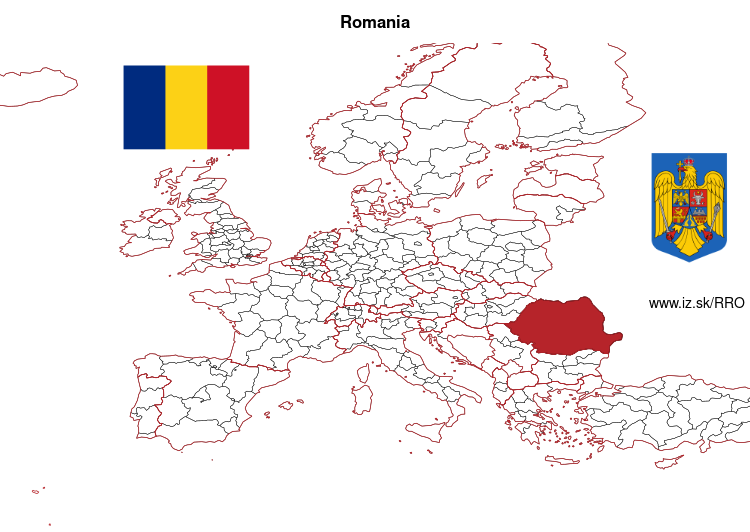
More on wikipedia wikidata Q218 on OpenStreetMap Romania slovensky: RO
Subregions: Macroregiunea Unu, Macroregiunea Doi, Macroregiunea Trei, Macroregiunea Patru
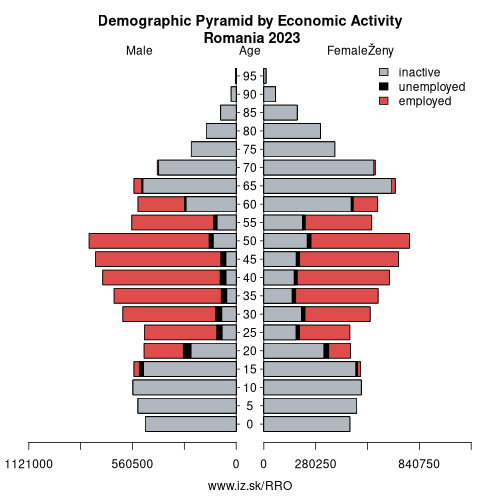
Unemployment
| Indicator | Period | Value |
|---|---|---|
| Unemployment | ||
| unemployment rate | 2024 | 5.4 |
| youth unemployment rate | 2024 | 23.9 |
| unemployment rate of low educated people | 2025q3 | 15.9 |
| Long term unemployment | ||
| long term unemployment | 2024 | 1.8 |
| share of long term unemployed | 2024 | 33.4 |
Composition of population according to age group, education and economic activity, Romania
| Age group | Low education | Middle education | High education |
|---|---|---|---|
| Y20-29 | P: 374.8 E: 161.5; U: 37.6; I: 175.7 | P: 1220.5 E: 622.9; U: 70.1; I: 527.5 | P: 269.0 E: 205.6; U: 12.7; I: 50.7 |
| Y30-39 | P: 504.8 E: 237.6; U: 48.2; I: 219.0 | P: 1324.0 E: 1087.6; U: 49.7; I: 186.7 | P: 588.5 E: 550.4; U: 7.9; I: 30.2 |
| Y40-49 | P: 558.1 E: 303.5; U: 41.6; I: 213.0 | P: 1707.1 E: 1444.5; U: 52.2; I: 210.4 | P: 615.4 E: 593.6; U: 5.2; I: 16.6 |
| Y50-59 | P: 454.0 E: 214.6; U: 23.8; I: 215.6 | P: 1910.1 E: 1436.4; U: 55.1; I: 418.6 | P: 357.1 E: 328.7; U: 2.2; I: 26.2 |
| Y60-69 | P: 648.6 E: 73.1; U: 8.1; I: 567.4 | P: 1527.0 E: 293.8; U: 6.6; I: 1226.6 | P: 208.5 E: 74.9; U: 0.1; I: 133.5 |
Note: in thousands in 2023, according to labour force sample survey. P – total population, E – employed, U – unemployed, I – number of economically inactive
Demographics
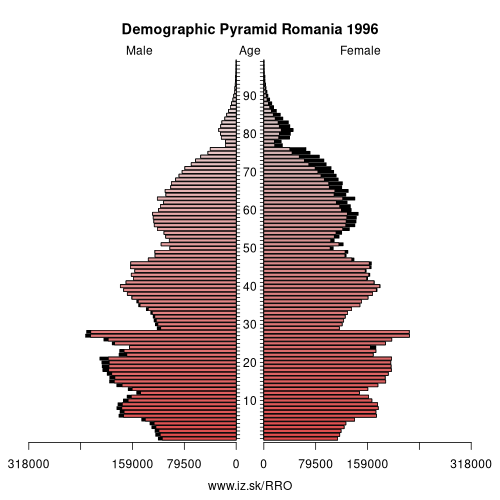
| Indicator | Period | Value |
|---|---|---|
| Demographics | ||
| number of inhabitants | 2024 | 19 067 576 |
| population density | 2023 | 81.4 |
| old-age dependency ratio | 2024 | 31.2 |
| Population ageing | ||
| unemployment rate – over 55 years | 2025q3 | 3.8 |
| aggregate replacement ratio | 2024 | 0.46 |
| aggregate replacement ratio – females | 2024 | 0.46 |
| life expectancy of a 50 year old | 2023 | 28.9 |
| healty life expectancy at 50 years | 2023 | 13.2 |
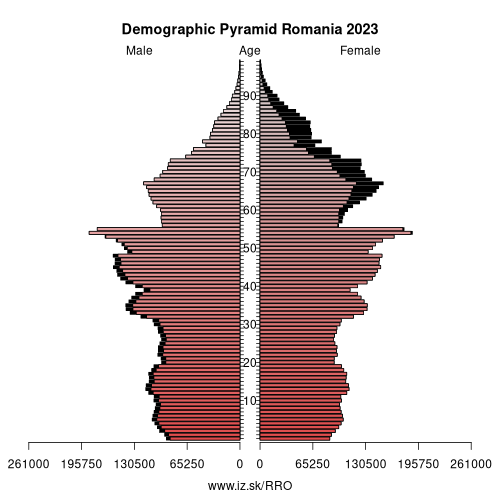
Employment by sectors, Romania
| NACE r2 | % | NACE r2 | % | ||
|---|---|---|---|---|---|
| A | 884.6 | 11% | B-E | 1724.5 | 22% |
| F | 839.9 | 11% | G-I | 2195.8 | 28% |
| J | 206.7 | 3% | K | 98.5 | 1% |
| L | 24.5 | 0% | M_N | 465.8 | 6% |
| O-Q | 1204 | 15% | R-U | 209.2 | 3% |
| TOTAL | 7853.3 | 100% |
Data for the period year 2024. Source of the data is Eurostat, table [lfst_r_lfe2en2].
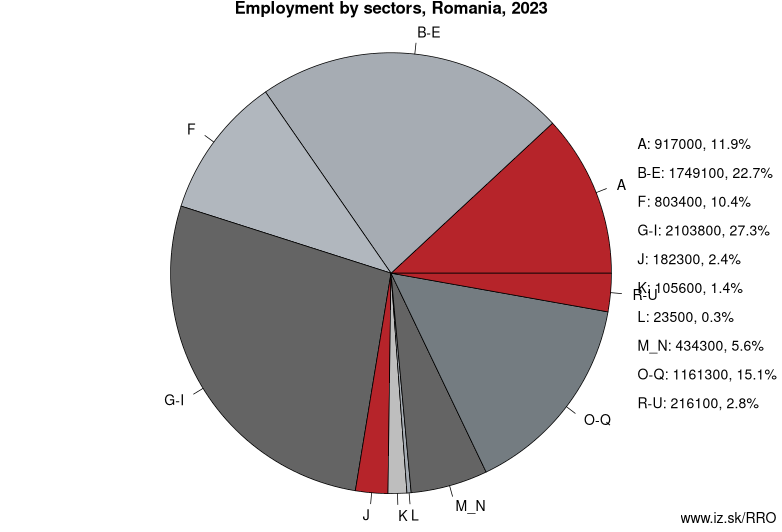
Romania ( (listen) ro-MAY-nee-ə; Romanian: România [romɨˈni.a] (listen)) is a country located at the crossroads of Central, Eastern, and Southeastern Europe. It borders the Black Sea to the southeast, Bulgaria to the south, Ukraine to the north, Hungary to the west, Serbia to the southwest, and Moldova to the east. It has a predominantly temperate-continental climate. With a total area of 238,397 square kilometres (92,046 sq mi), Romania is the 12th largest country and also the 7th most populous member state of the European Union, having almost 20 million inhabitants. Its capital and largest city is Bucharest, and other major urban areas include Cluj-Napoca, Timișoara, Iași, Constanța, Craiova, and Brașov.
The River Danube, Europe's second-longest river, rises in Germany's Black Forest and flows in a general southeast direction for 2,857 km (1,775 mi), coursing through ten countries before emptying into Romania's Danube Delta. The Carpathian Mountains, which cross Romania from the north to the southwest, include Moldoveanu Peak, at an altitude of 2,544 m (8,346 ft).
Modern Romania was formed in 1859 through a personal union of the Danubian Principalities of Moldavia and Wallachia. The new state, officially named Romania since 1866, gained independence from the Ottoman Empire in 1877. Following World War I after declaring its neutrality in 1914, when Romania fought on the side of the Allied powers starting with 1916, Bukovina, Bessarabia, Transylvania as well as parts of Banat, Crișana, and Maramureș became part of the sovereign Kingdom of Romania. In June–August 1940, as a consequence of the Molotov–Ribbentrop Pact and Second Vienna Award, Romania was compelled to cede Bessarabia and Northern Bukovina to the Soviet Union, and Northern Transylvania to Hungary.
Neighbours: Bulgaria, Serbia, Hungary
Subregions: Macroregiunea Unu, Macroregiunea Doi, Macroregiunea Trei, Macroregiunea Patru
Suggested citation: Michal Páleník: Europe and its regions in numbers - Romania – RO, IZ Bratislava, retrieved from: https://www.iz.sk/PRO, ISBN: 978-80-970204-9-1, DOI:10.5281/zenodo.10200164

 Share
Share Facebook
Facebook Twitter
Twitter News
News